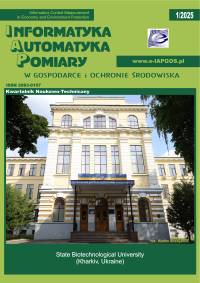THE CONCEPT OF A FLYING ELECTROMAGNETIC FIELD MEASURING PLATFORM
Sławomir Szymaniec
Opole University of Technology, Faculty of Electrical Engineering, Automatic Control and Informatics Institute of Computer Science (Poland)
https://orcid.org/0000-0002-7642-1456
Sławomir Szymocha
Opole University of Technology, Faculty of Electrical Engineering, Automatic Control and Informatics Institute of Computer Science (Poland)
https://orcid.org/0000-0001-6548-9896
Łukasz Miszuda
lukaszmiszuda@wp.plOpole University of Technology, Faculty of Electrical Engineering, Automatic Control and Informatics Institute of Computer Science (Poland)
https://orcid.org/0000-0003-0289-053X
Abstract
Nowadays, humans are surrounded by more and more devices that artificially generate an electromagnetic field. According to law, supervision of the level of the electromagnetic field requires specific measurements. Measurement performed by traditional methods have several limitations, which come from the infrastructure and time taken to perform the measurement. New methods of measurement are being developed in order to execute the research relatively quickly and repeatedly without any limitations. One of the methods is to use a flying mobile measurement platform.
Keywords:
electromagnetic field, flaying platform, measuringReferences
Beni G., Wang J.: Swarm Intelligence. Proceedings of the Seventh Annual Meeting of the Robotic Society of Japan, 425–428, 1989.
Google Scholar
Butlewski R., Kasprzyk R.: Pole elektromagnetyczne jako czynnik szkodliwy w przemysle elektroenergetycznym. Zeszyty Naukowe Politechniki Poznańskiej. Organizacja i Zarządzanie 59, 19–23, 2013.
Google Scholar
Dyrektywa Parlamentu Europejskiego i Rady Europy 2013/35/UE z dnia 26 czerwca 2013 r. (available: 20.06.2019).
Google Scholar
Eberhart R., Kennedy J.: Particle swarm optimization. Proceedings of the International Conference on Neural Network, 1942–1948, 1995.
Google Scholar
Fritzel T., Strauß R., Steiner H., Eisner C., Eibert T.: Introduction into an UAV-based near-field system for in-situ and large-scale antenna measurements. 2016 IEEE Conference on Antenna Measurements & Applications (CAMA), 2016, 1–3, [DOI: 10.1109/CAMA.2016.7815762].
DOI: https://doi.org/10.1109/CAMA.2016.7815762
Google Scholar
Gruber J., Jóźwiak I., Kowalczyk D.: Metody odzyskiwania i kasowania danych z nośników magnetycznych i nośników pamięci flash. Zeszyty Naukowe Politechniki Śląskiej. Organizacja i Zarządzanie 74, 2014, 35–44.
Google Scholar
Gryz K., Karpowicz J.: Zasady oceny zagrożeń elektromagnetycznych związanych z występowaniem prądów indukowanych i kontaktowych. Podstawy i Metody Oceny Środowiska Pracy 4(58), 2008, 137–171.
Google Scholar
Lewicka M. Dziedziczak-Buczyńska M. Buczyński A.: Electromagnetic radiation influence on living organisms. Polish Hyperbaric Research 4(25), 2008, 33–41.
Google Scholar
Tomczykowski J.: Sieci energetyczne pięciu największych operatorów. Energia Elektryczna 5/2015, 23–25.
Google Scholar
Norma Ochrona pracy w polach i promieniowaniu elektromagnetycznym o częstotliwości od 0 Hz do 300 GHz: PN-T-06580:2002
Google Scholar
http://archiwum.ciop.pl/26003.html (available: 3.03.2018).
Google Scholar
http://www.opole.pios.gov.pl/wms/Pliki/2017/Ocena_wynikow_pomiarow_monitoringowych_PEM_za_rok_2016.pdf (available: 21.02.2018).
Google Scholar
http://www.wavecontrol.com/rfsafety/en/ (available: 16.05.2018).
Google Scholar
http://www.who.int/mediacentre/factsheets/fs193/en/ (available: 10.04.2018).
Google Scholar
http://www.wios.lodz.pl/Monitoring_promieniowania_elektromagnetycznego_PEM,38 (available: 20.04.2018).
Google Scholar
https://pem.itl.waw.pl/artyku%C5%82y/pomiary-pem-w-otoczeniu-stacji-bazowych-telefonii-kom%C3%B3rkowej-sbtk-oraz-punkt%C3%B3w-dost%C4%99pu-lokalnych-sieci-dost%C4%99pu-bezprzewodowego-rlan/ (available: 1.07.2018).
Google Scholar
https://tech.nikkeibp.co.jp/dm/atclen/news_en/15mk/010401054/?ST=msbe&P=3 (available: 20.06.2019).
Google Scholar
https://www.aspen-electronics.com/wcrange.html(available: 10.04.2018).
Google Scholar
https://www.piit.org.pl/wazne/pem (available: 10.05.2018).
Google Scholar
https://www.riseabove.com.au/powerline-power-tether-system-for-drones (available: 20.06.2019).
Google Scholar
https://www.wavecontrol.com/rfsafety/images/datasheets/en/cMonitEM _Datasheet_EN.pdf (available: 20.06.2019).
Google Scholar
Authors
Sławomir SzymaniecOpole University of Technology, Faculty of Electrical Engineering, Automatic Control and Informatics Institute of Computer Science Poland
https://orcid.org/0000-0002-7642-1456
Authors
Sławomir SzymochaOpole University of Technology, Faculty of Electrical Engineering, Automatic Control and Informatics Institute of Computer Science Poland
https://orcid.org/0000-0001-6548-9896
Authors
Łukasz Miszudalukaszmiszuda@wp.pl
Opole University of Technology, Faculty of Electrical Engineering, Automatic Control and Informatics Institute of Computer Science Poland
https://orcid.org/0000-0003-0289-053X
Statistics
Abstract views: 356PDF downloads: 222
License

This work is licensed under a Creative Commons Attribution-ShareAlike 4.0 International License.
Most read articles by the same author(s)
- Mariusz Rzasa, Sławomir Pochwała, Sławomir Szymaniec, METHOD OF DETERMINING THE COP COEFFICIENT FOR A COOLING SYSTEM , Informatyka, Automatyka, Pomiary w Gospodarce i Ochronie Środowiska: Vol. 10 No. 4 (2020)








